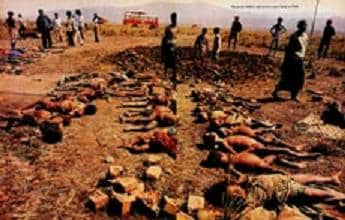
Assamese nationalism is a cultural project of the caste Assamese middle class. They have remained true to their conviction of the ‘anti-foreigner’ consciousness. The psychology of hate for the ‘outsider’ manufactured by this middle class became a norm in the public sphere in Assam. Any deviation from this norm turns one into an anti-cultural actor and destroyer of culture. Any form of criticism of Assamese nationalism is met with similar responses, much like how the Hindu nationalists resort to when Hindutva is questioned. It is to this psychological and political portrait one can also read the silence around detention camps, suicides, and the gross violation of human rights and dignity of people within the NRC process. Nellie too.
One of the most brutal events in the history of Assamese Nationalism is the Nellie massacre. It took place on 18th February 1983 during the Assam Movement (1979-85). There were other massacres too in places like Silapathar and Choulkhowa. The leaders of the Assam movement created ample space for negative political emotions around the idea of the ‘foreigner.’ Riding on the communal hate released by the leaders of the Assam Movement on the body of the ‘foreigner’, who in the public image was a ‘Bangladeshi Muslim,’ we saw for the first time in the history of Assam such a mass crystallization of absolute hate and suspicion about the ‘outsider.’ Assam Movement further communalised the caste Assamese middle class.
Political emotions are never to be undermined under any circumstance. Not too long ago, we saw how Rakesh Tikait’s emotional appeal pulled the protesters back from withdrawal. In all cases of anti-migrant sentiment, hate and disgust form the primary political emotions that are directed at the migrant other. One way to constitute such emotions is to portray the victim as scavengers of resources and a danger to the dominant culture of the place where they migrate to. Census documents in the early decades of the 20th century, popular songs, and even graffities in Guwahati city carry those sentiments of ‘scavenging’, much like how ‘termite’ is used by the right-wing in India. The leaders of the Assam Movement successfully managed to construct such an image about the migrants with roots in erstwhile East Bengal. It was those similar sentiments cultivated for many decades that led to the events in Nellie and its nearby areas whereas per the official count over 2000 people belonging to the Bengali Muslim community were massacred with machetes and country-made weapons. The unofficial count puts the victims at many more thousands.
Like most communal violence, the preparators often belong to the contiguous communities of the victims. This story is the same from Rwanda to Godhra. Nellie is also not an aberration to that social fact. In the face of the Nellie genocide, the leaders of the Assam Movement denied any involvement with the killings that took place in Nellie. Who is to then blame for flaring such communal tension and negative political emotions that led to the fateful events in Nellie and adjoining areas? The leaders of the Assam Movement who enjoyed significant political success after signing the Assam Accord continue to deny their influence and their role that made Nellie possible.
Nellie doesn’t exhaust the victimhood of the migrant outsider in Assam. The evil to which the victims of Nellie were subjected will remain a dark event in the history of Assam, albeit being erased and forgotten in public life. One would notice that events such as Nellie have never become a source of reflection for the Assamese political society about the evil that a society can produce in its critical moments. The multiple harassments directed particularly at the Bengali Muslim community during the NRC process bring to life those political emotions with more force. Nellie generated social fear among the Bengali Muslim community in Assam. This fear benefitted the chauvinistic forces in the state in legitimising their narrow nationalism. We are a society that fears to face our imperfections and the social cost of it is immense.
Many popular songs, poems, literary societies, film actors, singers, intellectuals, official documents, bureaucratic officials, and historiography have profiled the migrant in Assam as a danger, a monster who must be detected, deported, detained, and stripped off from all political and economic rights as a citizen. Years of continued efforts from such varied people managed to cement such hate about the ‘migrants’ in Assam and make Nellie, Choulkhowa Chapori, Silapathar, and NRC a reality.
The excess carried out in Nellie is often wiped by the 855 martyrs of the Assam Movement. How can one wrong be wiped off by another wrong? No one is denying the death of the 855. The larger question is why are some victim martyrs and others forgotten despite being victims in the same political event? Why are so many victims from Dhola-Sadiya to Silapathar whose names we forget and bodies we don’t count are Bengali Dalit Namasudras of which a majority are women in Silapathar if not more, as writer Devabrata Sharma and his intellectual collaborators had asked? Sharma further asks: why are those most victims during the anti-colonial struggle and in Assam’s post-colonial history belong primarily to the Miya Muslims, ST-SC-OBC minorities, and left activists belonging to different left groups in the state? Furthermore, why is it that the people who benefitted from such martyrdom are predominantly the ruling class who are the caste Assamese? These questions should stir our consciousness and reservations.
Between remembering the martyr and forgetting the victim, a minority, we find Assamese society turning its back on its own secular tradition.
Suraj Gogoi is a PhD candidate in Sociology at NUS.
GET COUNTERCURRENTS DAILY NEWSLETTER STRAIGHT TO YOUR INBOX
Related posts:
Related posts:
Views: 0
 RSS Feed
RSS Feed

















 February 18th, 2021
February 18th, 2021  Awake Goy
Awake Goy  Posted in
Posted in  Tags:
Tags: 
















